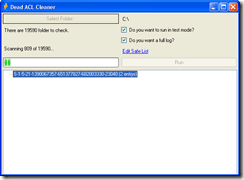a·gen·tic a·gil·i·ty
Removing ACL's for dead AD accounts
TL;DR; Explains how to identify and remove access control entries (ACLs) for deleted Active Directory accounts using .NET, including challenges and code examples for automation.


TL;DR; Explains how to identify and remove access control entries (ACLs) for deleted Active Directory accounts using .NET, including challenges and code examples for automation.


 I have run into a very vexing problem with one of my applications. I was asked to provide an application that would fin all of the permissions set against Active Directory accounts that have been since removed. These normally show up in the permissions dialogs for folders as the full SID of the account as there is no longer nay way to look it up in Active Directory.
I have run into a very vexing problem with one of my applications. I was asked to provide an application that would fin all of the permissions set against Active Directory accounts that have been since removed. These normally show up in the permissions dialogs for folders as the full SID of the account as there is no longer nay way to look it up in Active Directory.
 I have written a nice little threaded application that lets you select a folder and it finds all of the dead accounts. What it actually does is verify all accounts against Active Directory and flags them if they are not found. This will have the side effect of finding groups and local accounts and thinking they are dead as well. To solve this problem I added a “Safe List” of accounts and as way to add them from the GUI. The system then ignores any account names that are in this list.
I have written a nice little threaded application that lets you select a folder and it finds all of the dead accounts. What it actually does is verify all accounts against Active Directory and flags them if they are not found. This will have the side effect of finding groups and local accounts and thinking they are dead as well. To solve this problem I added a “Safe List” of accounts and as way to add them from the GUI. The system then ignores any account names that are in this list.
All is well…
But not really. As I moved on to actually deleting the offending ACL’s on request, I found it was a little more difficult to actually delete them as .NET seams to ignore my code…
1Private Sub RemoveACL(ByVal DirectoryName As String, _ 2 ByVal IdentityReference As Security.Principal.IdentityReference) 3 Dim DS As DirectorySecurity 4 DS = System.IO.Directory.GetAccessControl(DirectoryName) 5 6 DS.PurgeAccessRules(IdentityReference) 7 DS.PurgeAuditRules(IdentityReference) 8 9 System.IO.Directory.SetAccessControl(DirectoryName, DS) 10End Sub
Now, this code is fairly simple. First we get the directory security object, then we change the directory security object, and then we save the directory security object.
The “DirectoryName” object contains a CuteFTP folder:
The “IdentityReference” object contains the offending SID:
This code should work, and I have used a similar piece to add permissions, so why on earth can’t I remove them!
UPDATE: I have added a question about this to the MSDN Forums
Technorati Tags: .NET
If you've made it this far, it's worth connecting with our principal consultant and coach, Martin Hinshelwood, for a 30-minute 'ask me anything' call.
We partner with businesses across diverse industries, including finance, insurance, healthcare, pharmaceuticals, technology, engineering, transportation, hospitality, entertainment, legal, government, and military sectors.

ProgramUtvikling

Emerson Process Management

Workday

Slicedbread

Akaditi

Lean SA

Flowmaster (a Mentor Graphics Company)

Slaughter and May

Higher Education Statistics Agency

Kongsberg Maritime

Alignment Healthcare

ALS Life Sciences
Boxit Document Solutions

Epic Games

Milliman

Trayport

New Signature

Sage

Royal Air Force

New Hampshire Supreme Court

Washington Department of Transport

Washington Department of Enterprise Services

Department of Work and Pensions (UK)

Nottingham County Council
CR2

Genus Breeding Ltd

Lean SA

Jack Links

ProgramUtvikling
Boxit Document Solutions